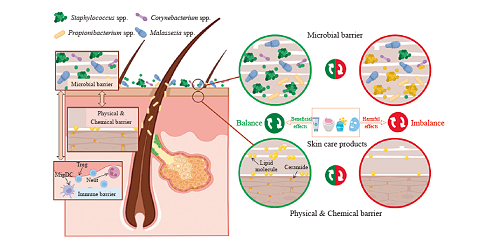皮肤微生物组及其生存环境共同构成了皮肤微生态系统,发挥着重要的屏障作用。微生物组是皮肤微生态系统的核心,其通过介导物理屏障、化学屏障以及免疫屏障的相互作用,维持着皮肤稳态。日常使用护肤品已成为现代人的生活习惯,其对皮肤微生态的影响不容忽视。为此,本文综述了护肤品中可能影响皮肤微生态的各类因素,从共性影响、有害影响、有益影响、不确定性影响几个角度进行了系统分析。在此基础上,讨论了微生态护肤品的研发方向。
The skin microecosystem is comprised of the components including: the microbiome, encompassing bacteria, fungi, archaea, viruses, protozoa, and other microorganisms; host cells, including epithelial cells, immune cells, and various glands; chemical constituents, such as sebum, sweat, skin care products, environmental molecules, and their metabolic products; and the physical microenvironment, which includes factors such as oxygen, ultraviolet light, and temperature. The microbiome serves as the central component of the skin microecosystem, playing a crucial role in the maintenance of skin homeostasis through its mediation of the interactions among the physical barrier, chemical barrier, and immune barrier. Understanding the skin microecosystem, and how to maintain its delicate balance is an essential way to gain insight into the mechanisms responsible for healthy skin. The daily use of skin care products has become a modern living habit, and its impacts on skin microecosystem cannot be ignored. Therefore, this article aims to summarize the various factors that may affect the skin microecosystem in skin care products, and systematically analyze the common effects, harmful effects, beneficial effects and uncertainty effects. Based on this premise, the following development directions are proposed: further elucidation of the skin microecology mechanism with multi-omics technology, the creation of in vitro skin microecology models, the establishment of evaluation systems and regulations for assessing the effects of skincare products on skin microecology, and the exploration of beneficial skin bacteria and substitutes for potentially harmful ingredients.



